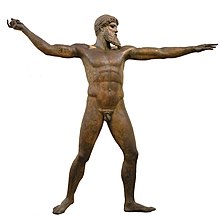Poseidon from Cape Artemision
The statue known as Poseidon from Cape Artemision or also as Zeus from Cape Artemision (often referred to as "God from the Sea") is one of the few Greek bronze figures from the 5th century BC. Chr. That have been preserved. It is now in the National Archaeological Museum of Athens (Inv.-No. 15161).
Find
The standing figure of a bearded man with far-reaching arm movements was discovered in 1926 near an ancient shipwreck off Cape Artemision in the north of the island of Evia . Investigations of the site where the statue's right arm was found also took place in 1928. But a diver died here; then the research was stopped and has not been resumed since. In the same wreck, the so-called rider from Cape Artemision was discovered.
description
The bronze figure is 2.09 meters tall; the span of the outstretched arms is also over two meters. The person depicted is naked and muscular; the left leg is the actual supporting leg, while the right leg with the slightly raised heel is primarily used to support and maintain balance. The right hand, which was stretched far back, used to hold a javelin, a trident or something similar. The left arm is also raised and, together with the extended hand, forms a bearing line and a counterweight to the limb.
The head is aimed at the target. The mouth is closed; the eyes - formerly probably made with ivory - or bone discs and a central iris made of dark stone or glass - fix the target. Whiskers and forehead curls hang down like braids; the hair on the head is held together by a braided band. While the tension can be felt in the body immediately before the throw, the facial expression is calm and focused.
Dating
Due to the figure style, which unites clearly realistic with more severe features (beard), the bronze statue is around the year 460 BC. Dated. While the time of origin is largely certain, the creator of the figure is unknown - Kalamis (active around 470-440 BC), Onatas from Aegina or Myron were named .
interpretation
Overall, the body of the statue looks like that of an athlete or warrior, but research has been interpreting the figure as either the sea god Poseidon or his brother Zeus himself for a long time . The interpretation depends on the lost throwing device: a spear would clearly be an athlete or be assigned to warriors; a trident would characterize the figure as Poseidon; a lightning bolt would undoubtedly point to Zeus.
Trivia
In the expedition report "People and Sharks", diving pioneer Hans Hass lets his colleague Xenophon, d. i. Alfons Hochhauser , telling the story of the discovery and recovery of the statue. Hochhauser claims to have been there during the rescue.
In the thirteenth chapter of Werner Helwig's Greek novel "Reise ohne Heimkehr" (Journey without Homecoming), a fictional story is built into it, which was later published several times separately under the title "Poseidon's return" or "Poseidon's end". Here too, adventurous circumstances in the discovery and recovery of the statue are reported, which are probably based on Hochhauser's stories.
In his novel "Alfons Hochhauser - The Barefoot Prophet of Pelion", published in Greece in 2010, Kostas Akrivos takes on Hochhauser's stories without questioning them. However, he also writes that the National Archaeological Museum of Athens informed him upon request that its documents did not show that the Austrian Alfons Hochhauser was involved in locating and recovering the bronze statue.
Further information
Greece, which joined the Council of Europe on August 9, 1949 , gave the organization a replica of the "Poseidon of Cape Artemision" in 1998, which is located in front of the main building of the Council of Europe in Strasbourg .
See also
The Poseidon from Cape Artemision is one of only seven preserved Greek and Great Greek bronze statues. The others are the pugilist from the Quirinal , the charioteer from Delphi , the horseman from Cape Artemision , the two bronze statues from Riace and the ruler of the thermal baths . The fragment of the so-called Chatsworth-Apollo should also be mentioned in this context .
literature
- Raimund Wünsche: The God from the Sea. In: Yearbook of the German Archaeological Institute. Vol. 94, 1979 pp. 71-111.
Individual evidence
- ↑ Hans Hass: Menschen und Haie, Zurich 1949, pp. 108–110
- ↑ Werner Helwig: Journey without homecoming, 1953. Quoted from the Reclam edition, pp 79-93, Stuttgart 1993
- ↑ z. B. in Merian monthly issue, 14th year, 1961, issue 11, Aegean Island World.
- ↑ Kostas Akrivos: Alfons Hochhauser - The Barefoot Prophet of Pelion, Frankfurt, megalomania 2012, p. 174 ff
- ↑ Kostas Akrivos: Alfons Hochhauser - The Barefoot Prophet of Pelion, Frankfurt, megalomania 2012, p. 100 f

